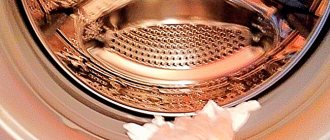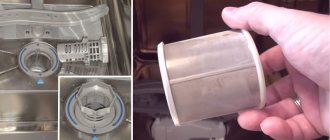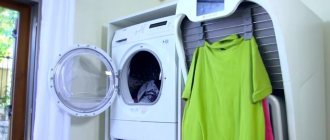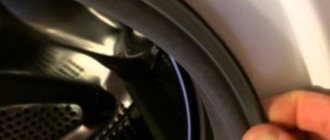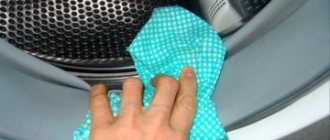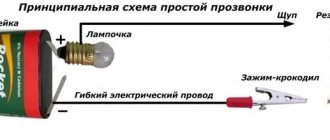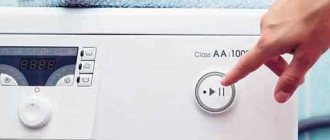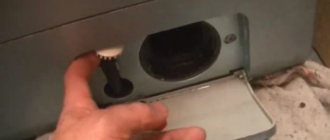Using a washing machine, you can easily wash all linens and clothes, including delicate and bulky textiles. Like any other household appliance, the washing machine requires proper care, otherwise problems will appear, including an unpleasant odor. Let's figure out why this happens and how to remove the smell from an automatic washing machine.
The video showed how to clean the machine to remove the smell
What exactly can a washing machine smell like?
The most disgusting smell that can come from a machine is the smell of fungal mold. It is so sharply sweet and smells simply disgusting. It's downright heartbreaking. And it’s absolutely impossible to wear something that smells like that.
Also, the machine may smell of acetone, gasoline or other chemicals. But in this case, everything is not so scary, since the culprit is some dirty thing in gasoline that you threw into the washing machine. And such a smell washes out on its own. A couple of washes with some old sheet and that’s it, the problem is solved.
So, there is no point in talking about this; it’s better to discuss how to detect and neutralize the moldy smell. This is really a problem that can lead to not only unnecessary expenses, but also endless fuss.
Call a plumber
To quickly remove the stench without damaging the equipment, they call a technician from the service center. The plumber will determine the source of foreign odors and perform the following procedures:
- wash the drain filter;
- cleans the drum, powder receptacle, rubber seals, door;
- will remove scale from the heating element;
- diagnoses the condition of the device, replaces worn parts that cannot be restored.
The technician will check the correct connection of the unit to the sewer pipes and correct any errors.
Places where fungus accumulates or why there is a smell in the washing machine
There are a lot of places like this, and it’s scary... It’s unlikely that anyone, the first time, was able to correctly determine where exactly the stink was coming from.
Sources of unpleasant odor in the washing machine can be:
- The drum itself, just not inside where you can see it, but from behind;
- Channel through which detergents are supplied;
- Tray (cuvette) for powders;
- Heating heating element (especially if it has begun to oxidize);
- Drain hose or filter;
- Stagnation of water in the lower part of the machine due to improper installation/setting;
- General communications pipes (only in old houses).
As you can see, there are plenty of places that are not so easy to clean. But the worst thing is the last option. Below we will describe step by step how to deal with the smell in each specific case. In the meantime, read the hint to our long article.
Adviсe
A few tips from experienced craftsmen will speed up the process of removing unpleasant odors from the washing machine:
- A clogged drain corrugated hose that could not be cleaned the first time requires replacement.
- A baking soda paste (the powder is diluted with water into a thick paste) will help to quickly clean the rubber cuff from black deposits and unpleasant odors.
- An effective remedy in the fight against unpleasant odors of mold and mildew is copper sulfate. For cleaning, use a solution prepared at the rate of 1.5 tbsp. copper sulfate per liter of clean water. Wipe the cuffs with a rag soaked in the prepared mixture. Additionally, a solution of copper sulfate is poured into the drum, after which the wash is started at a water temperature of 95°C.
When cleaning the washing machine, do not forget about personal protective equipment - rubber gloves and a respirator.
You will find a lot of useful and important information about removing various unpleasant odors from objects and surfaces in this section.
Is there one universal way to get rid of odor?
Many people think that it is not at all necessary to look for something there and clean it, you can just take and run the machine using some kind of chemical. After all, in theory, it should get into all the places and crevices and automatically wash out the suspected areas where fungus accumulates.
In principle, this is the right decision and you should always start with it. But, keep in mind that washing must be done not just once, but a couple of times in a row.
Why is that? But because an acid or other chemical substance may not completely break down the plaque the first time, but only “fluff” it, which will only intensify the stench. Therefore, rinse twice and if this does not help, then you will have to look for the root of the evil...
Household chemicals
To choose the right product, the housewife needs to test several.
When available products do not get rid of the rotten smell from the washing machine, household chemicals are used. The dose of the substance is calculated according to the instructions. After treatment, wash dry with an additional rinse cycle.
Tiret
Disinfects; Safely removes lime and greasy deposits and scale. Neutralizes stench. Pour in the gel and start the cycle at +60℃. To improve the performance of the machine, apply it once every six months.
Doctor ten
Acid-free antibacterial powder contains triclosan, alkali metal carbonates. Disinfects. Removes limescale build-up from the internal surfaces of the unit and cleans the heating element. Dissolves detergent residues. Prevents the formation of mold in the machine and in the drain pipe.
The cleaner quickly eliminates the causes of stench
A pack of powder is poured into the drum, and the washing is turned on at high temperature (without spinning). For soft water use 2-4 times a year, for hard water – up to 10 times.
Reference! Citrus peels or peeled potatoes placed in an ajar machine after washing will absorb foreign odors.
Chistolan-super for removing scale
Inexpensive effective remedy. Contains citric acid and sodium chloride. Dissolves scale. Does not damage rubber, plastic, metal parts. Set normal mode at +70℃. Wash without laundry.
Chistolan automatic – washing powder
Powder containing soda ash, tripolyphosphate and sodium sulfate is added to the detergent with each wash. Suitable for all types of fabric. Reduces the consumption of detergents. Prevents the formation of plaque, softens water, removes scale. Helps increase the life of the machine. It is used economically: with water of medium hardness, take 25 g of powder per 10 liters; with hard water, double the dose.
Special products are effective and at the same time do not damage rubber, plastic and metal.
Refine
Due to the high concentration of sodium carbonate (soda ash) and Trilon B, it intensively softens and removes dirt; dissolves rust. Manufacturers recommend adding 1 table for each wash in soft water. l. granules, hard – 2.5 – 3 table. l.
Dr Beckmann
Available in liquid and powder form. Contains citric acid, glycerin, activated carbon, surfactants. The antibacterial drug destroys dirt even in hard-to-reach areas. Extends the service life of the machine. Anti-corrosion and softening components do not damage metal or rubber.
MultiDez-Teflex
A concentrated chlorine solution destroys mold, fungal spores, viruses, and bacteria that cause stench. Does not damage metal or rubber elements. The parts are wiped with liquid. Without adding additional substances, wash the laundry or choose an empty wash (30 - 60 minutes).
Pipe cleaners will help clean the insides of your car.
Bagi Schumanit
Aggressive concentrated liquid. Thanks to a mixture of organic acids, it quickly removes water scale, rust, and limescale. Increases the heat transfer of the heating element. 0.2 liters of concentrate are poured into the powder compartment, the machine is turned on for 15 minutes, then the rinse program is selected.
Mellerud
Eliminates pollution and neutralizes stench. Pour 0.25 liters of solution into the detergent container, select a short program followed by rinsing. Used for soaking contaminated removable parts (take 0.2 liters of the drug per 8 liters of warm water). After 25 - 35 minutes, scrub with a brush and rinse with running water. The seals are wiped with a cloth soaked in the solution. After 15 minutes, wash off.
Frau Schmidt
The active ingredients include citric acid, sodium bicarbonate, and trisodium citrate. The tablets quickly corrode scale and fat deposits; removes residual detergents. One tablet is placed in the machine and the normal program is turned on without spinning.
Tablets are suitable for all car models
Cillit bang
Cleaning compositions of this brand clean surfaces from various types of contaminants. A spray containing chlorine gets rid of black mold on the rubber seal (spray on the rubber, after 20 minutes remove with a damp sponge, wipe off). Anti-Plain + Shine removes traces of rust, greasy dirt, and dissolves excess detergents on plastic and metal. The sprayer helps remove dirt in remote corners and at the joints of parts.
Additional Information! Before applying the compositions, the treated surfaces are moistened.
Dishwasher cleaning tablets
For the treatment of dishwashing equipment, tablets are produced that stop the growth of bacteria and prevent the formation of scale, rust, and lime deposits. The drugs also dissolve fat and protein deposits.
A powerful remedy is to combine boiling and dishwashing tablets
Therefore, these products are also suitable for eliminating bad odors from the washing machine. One capsule is placed in the powder compartment, and 2 - 3 in the drum. Start the boiling mode. Stop after 35-45 minutes. After 2 hours, treatment is resumed.
Buy chlorine-free hypoallergenic tablets containing a complex of washing and cleaning ingredients (Filtero 7 in 1; Somat Machine Cleaner; Finish Rinse).
What and how can you wash a washing machine?
Firstly:
“Idle” washing should be done only with hot water, in boiling mode.
This is the most important point. The second is the choice of means. It is not necessary to take expensive chemicals; if you wish, you can get by with folk remedies.
Calgon is a good thing, but it should be used in extreme cases. It removes scale, but it ruins the rubber. Cars break down very quickly if you get carried away with this product. You can only apply it once a year or if there is an odor.
Citric acid is no worse than Calgon, if not better. It perfectly dissolves scale and sediment and at the same time does not “kill” rubber. She can and should wash the machine “idle”, about once every two months. Just pour a pack of lemon juice into the drum and set the wash to boiling. This method helps to quickly get rid of problems.
Soda (we do not recommend) is a weaker remedy and can be used if there is absolutely nothing at hand and nothing is foreseen. But, frankly speaking, it is difficult to imagine such a situation in our 21st century.
Vinegar (we don’t recommend it) is an acid and, theoretically, it should clean no worse than lemon juice. But in reality, vinegar is no match for powdered citric acid concentrate. Not only is it not able to properly remove scale, but it also leaves behind such a smell that you will wash for a week and your clothes will smell like vinegar.
Bleach (we do not recommend) - it dissolves very well. The fungus is completely powerless against it. But then cleaning the car from the smell of bleach will not be so easy. You will need to run it three times, with clean water without additives, and then ventilate the machine for a long time. And most importantly, running with bleach is not a guarantee that the smell will definitely go away, since it may be in a place where the solution simply cannot reach.
So, what is the conclusion: it is best to start any cleaning with a run with lemon juice, since it dissolves well and there is no need to ventilate afterwards.
Reasons for the accumulation and development of microorganisms
The most common and common operating mistake is closing the hatch (horizontal loading) or the lid (vertical loading) immediately after washing. The machine needs time to evaporate moisture, so leave it open after use for at least 2-3 hours.
The second mistake is storing used clothes in a drum. High humidity plus dirty laundry is a breeding ground for the life of microorganisms.
It is recommended to store stale clothes in a special basket. It does not take up much space, and fungi and bacteria have less chance.
Wipe the drum and sealing rubber inside and outside with a dry cloth after each use of the machine so as not to create favorable conditions for the development of bacteria and fungi
They create a convenient platform for the development of microorganisms and some detergents. If they are of poor quality or used in excess, this will lead to the formation of mold in the washing machine.
Washing at low temperatures also contributes to the appearance of a foul odor.
Step-by-step ways to neutralize odor
Experimenting with powders and conditioners
Very often it is detergents that cause the smell. Cheap powders do not dissolve completely, therefore, after washing, the machine parts remain not clean, but stuck with microparticles of these miracle powders.
And, if you wash often, then there will be no problems. And, if once a week or less, then during this time mold has time to develop. Moreover, on any parts, even on those that cannot be “reached” by a run with citric acid.
Removing odor from the drum
Here we are not talking about whether the drum is dirty on the inside. The drum may be covered with mold from the outside, which means that only a workshop, a complete disassembly of the machine and significant expenses will save you.
There's a lot of dirt there, believe me. If you regularly do preventive maintenance, which you will read about below, then such a moment will come much later, but it will still come.
Removing odor from the powder tray
If you have a top-loading machine, then everything is simple. Take out the drawer and wash it thoroughly with an old toothbrush. If we are talking about a horizontal machine, where there is almost no access to the ditch, then you will have to dodge and clean the compartment with improvised means.
For example, you can wrap cotton wool around a thin, long knitting needle, soak it in alcohol or bleach and wipe it. You can simply pour bleach into it, but do not forget to then idle the car several times.
Cleaning the detergent supply channel
If it is clogged, then a knitting needle with cotton wool will help here too. But, in theory, it should be cleaned at the moment when you start a single wash with lemon.
And, frankly, this is not the place that is the source of the damage and where the smell might come from. But, careless owners can do anything, so we are listing this place just in case.
Cleaning the drain filter
In principle, there is almost no smell of fungus from the filter. Rather, it may smell, so to speak, not of fungus at all, but of garbage, since pieces of food may get in there. But, in any case, you need to take out this filter, check it and wash it thoroughly if necessary.
Removing scale from the heating element
The heating element, too, is unlikely to become covered with fungus. It becomes overgrown with a “fur coat” of scale. It, of course, can give off some very faint odor, but it has nothing to do with the smell of mold.
So, be that as it may, since you’ve already gotten there and “gutted” the machine, it’s worth paying attention to the heating element and cleaning it. You can remove it and soak it for a day or three in a strong lemon solution, this helps.
But, in general, heating elements need to be cleaned not only for the sake of cleanliness, but for the sake of saving energy.
The more coating the heating element is, the more current it draws to give the temperature required for washing. That is, it needs more power and time to heat the water. And such a load affects the motor... Everything in the machine is interconnected, just like in the human body.
Changing or cleaning the drain hose
Everything is simple here. Unplug it and smell it. If there is a smell, try soaking it in a bleach solution for a day. If this doesn’t help, then buy a new one and don’t fool yourself. It's not that much money.
Looking for stagnant water
It happens that the smell comes from the container below, where there is always some water left. In general, this is some kind of strange and exceptional case, since, in theory, there should always be water there to protect the rubber from drying out.
But, if you installed the machine incorrectly, at the wrong level, then there may be a misalignment and there will be much more water there than necessary. In general, we can’t say exactly why this happens, but in that exact place there definitely shouldn’t be a smell. Maybe you were away for a couple of months? Then maybe there was some kind of stagnation. And even then, this cannot be.
We are fighting with the housing office and demanding replacement of pipes
If your laundry starts to smell unpleasant, then don’t rush into fanfare and check if there is a smell from another tap that comes from the same pipe? Sometimes it is completely unnoticeable, for example, in the same bathroom.
Let’s say the first portion of water has some kind of smell, and then it is drained and, in the end, you simply don’t notice that there is a smell. The first batch of stagnant water from the pipes is drawn into the machine and it runs there throughout the entire cycle.
In general, if the problem is in the pipes, then the problem is the pipe. We will have to raise all the neighbors to their feet, collect signatures and go to the utility services, demanding that the pipes be repaired. This is a troublesome and slow task.
In our country, even in case of accidents, when the basement is completely flooded with sewage water, they don’t fuss too much, and in this case, even more so... But no one is stopping you from being persistent. What should we do if in our country they won’t move without a kick?
Causes of odor
The causes of odor can be divided into two groups. The first is associated with the most common problems, most often caused by violations of the operating rules of the device. The second includes hidden reasons; they are not so obvious and are less common.
Obvious
After installing the washing machine, you must carefully read the instruction manual and follow all its points. Then the causes of the odor will be eliminated:
- due to a closed hatch;
- contamination of sealing rubber;
- storing dirty things inside the drum;
- installing the device on an uneven surface;
- exceeding the amount of powder supplied to the container.
You need to follow the instructions to avoid such problems.
Hidden
It is not always possible to understand that the smell from the washing machine is caused by the following reasons:
- poor choice of powder;
- contamination of the surface of the tray and channel for supplying powder;
- clogging of the filter with large objects, which can even completely block the drainage of water;
- incorrect connection of the device to sewer pipes;
- the need to clean a silted drain hose;
- adhesion of a layer of scale mixed with dirt and debris on the heating element;
- The problem is in the general drainage system.
Sometimes finding out the source of an unpleasant odor requires the help of a professional.
How to prevent the appearance of a stale smell?
It is always better to do prevention than to urgently get rid of the consequences. So, what should you not do and what can you do to prevent mildew in your washing machine?
1. Do not store dirty laundry directly in the drum. When you put it in it is not always perfectly dry and it may well begin to “rot.” And after such a wash, the machine may smell two or three more times, and you will think that the problem is in some spare parts.
By the way, the fungus “blooms” most quickly on fabrics that were previously washed with a large amount of conditioner, and it was not completely rinsed.
2. Don't overdo it with conditioners. This is exactly the case when porridge with butter will ruin it. Try to purchase more or less high-quality chemicals that can be rinsed out in one wash.
3. Always leave the machine open after washing. Of course, everyone knows this, but for some reason not everyone does it. The moisture remaining on the walls of the washing machine after washing is quite enough to “proliferate” the fungus in just a week, but it will be difficult to remove the smell.
4. No need to pour powder into the tray! Pour it directly into the drum. The powder is never completely washed out of the cuvettes, especially when it comes to washing in cold water. And, if it’s easy to wash a tray in a machine with a vertical loading, then the ditch of a horizontal machine is practically inaccessible. If the powder compartment is empty, then no fungus will grow there. And if there are wet lumps of powder there all the time, then you understand that they will become covered with black spots.
5. Try to rarely use the cold water wash cycle. This is not such a saving, believe me. But your things are not washed from excess powder, and the machine parts themselves are not washed during the washing process, which means fungus is not far off. And the fungus, not only does it smell disgusting, it also kills you. However, the remaining powder that you breathe in every day also kills in the same way.
Service center services
Some owners find it difficult to pay a little attention to their household appliances, so they turn to the services of specialized service centers to clean the washing machine from odors and dirt. The cost of such work is low, because no parts need to be changed, but it will take at least 1 hour. Moreover, even if you regularly wash the tray and ventilate the drum, there are still places where organic matter accumulates. Disinfecting all parts will help get rid of them. It is quite possible to order such services in our service center, and they will be provided at the proper level.
Specialists will perform the following work:
- They will disassemble the equipment, or rather, dismantle those parts in which accumulations of organic matter are most likely formed.
- All parts will be cleaned and all components will be disinfected.
- They will perform forced drying after treatment, because remaining moisture can cause the unpleasant odor to spread again.
Preventative techniques
If you follow simple rules, you won’t have to look for a way to deal with the stench from your washing machine:
- Washed items are rinsed thoroughly.
- Buy high-quality detergents for washing in the machine. The granules of such powders do not stick together, dissolve well in water, and foam moderately.
- You cannot pour dishwashing concentrates into the machine: excess gel is not completely rinsed out of the fibers and remains on the surfaces of the unit. Excessive foaming causes damage to the heating element.
- Before loading, remove hair and dried dirt from clothes; remove foreign objects from pockets. Check whether buttons and small details are securely sewn on.
- After wet processing and washing, the drum is thoroughly wiped and ventilated.
- Dirty clothes should not be stored in the drum as this increases the risk of mold growth. Contaminated laundry is placed in baskets or containers that allow air to pass through.
- The cuff is a rubber seal installed between the drum and the door so that water does not spill out of the appliance during washing. Without regular cleaning and drying, water stagnates here, mold and dirty deposits appear. This part is periodically wiped with diluted acetic acid.
- The device is installed on a flat surface, according to the diagram in the instructions.
- After finishing washing, wipe the internal surfaces of the machine, rubber seals and tray with a damp soft cloth. Then wipe dry and ventilate.
- The corrugated hose quickly becomes dirty and is difficult to clean from deposits. If it is not possible to remove contamination from the inside, the part is replaced with a new one.
If you take care of the cleanliness of your machine, the smell of freshly washed laundry will only delight you.
When trying to get rid of the stench, you must not exceed the permissible concentration of cleaning agents or use different agents at the same time: aggressive substances will damage plastic and rubber parts and cause metal corrosion.
The appearance of bacteria and mold
The smell of dampness often occurs as a result of contamination of the rubber sealing elements and the metal drum. If you regularly wash using low temperatures, the internal parts of the machine become covered with bacteria. Subsequently, mold forms on them. It is usually black in color.
The causes of mold are:
- wash at low temperature;
- use of liquid detergents;
- scale on the surface of the heating device;
- permanently closed loading hatch of the washing unit.
